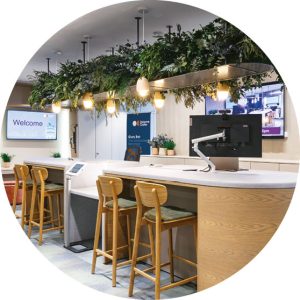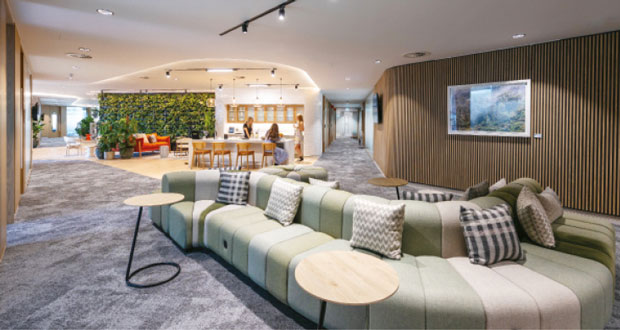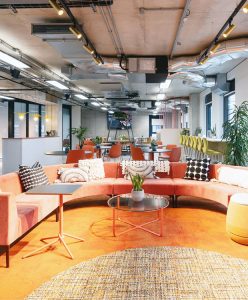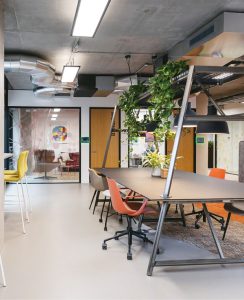RECRUITMENT AND RETENTION
As well as flexibility, the so-called war for talent and meeting ESG (environmental, social and governance) goals are also top considerations for organisations, and again, FMs are in an ideal role to spearhead ESG initiatives within their organisations.
Office space is a vital way for organisations to demonstrate their culture and values, with prospective talent prioritising creative, welcoming spaces that encourage team members to come together and collaborate. If people return to the office to save on their household bills, they want it to be a comfortable and stimulating place to work.
Many organisations now have a range of policies designed to support and empower their employees and demonstrate their values. These have manifested most visibly in initiatives championing equality, diversity and inclusion, mental health, and learning and development.
Businesses that make a point of implementing such policies and practices are seen as a huge draw for talent looking for new roles, as they demonstrate additional care and consideration for the wellbeing of their employees.
Facilities managers are at the forefront in ensuring the office is attractive to candidates as an environment which focuses on wellbeing and demonstrates an awareness of employees’ priorities and values.
 For example, changing spaces, showers, and space for fitness classes are opportunities for occupants to feel more energised, while quiet rooms and relaxation spaces encourage them to rest and take breaks. Office spaces with these wellbeing offerings are in high demand.
For example, changing spaces, showers, and space for fitness classes are opportunities for occupants to feel more energised, while quiet rooms and relaxation spaces encourage them to rest and take breaks. Office spaces with these wellbeing offerings are in high demand.
To support hybrid working practices, businesses are prioritising collaborative areas for employees. These often come in the form of on-site cafés, reception areas, break-out spaces and quiet spaces for focussed work.
SUSTAINABLE DESIGN
The sustainability of your workspace is likely to be important to your people, with 67 per cent of employees demanding their business becomes more sustainable(i).
There are many things you can do to ensure your space is more ethical and sustainable, but understanding the workspace’s current environmental footprint is a good place to begin.
This may be as simple as developing trackers to measure things like energy or water use, or conducting a lifecycle analysis on the materials used within the office fit-out, to determine the environmental impact over the building’s lifetime.
It’s also important to ensure that the physical components of your interior are ethically made and use sustainable or reclaimed materials, ideally nationally rather than internationally sourced. This should include furniture, décor and other design features.
The office should also be a highly energy efficient environment. Use technology such as LED lighting fixtures, smart lighting and environment controls and HVAC systems, all powered by renewable or green energy sources. Not only is this good for the planet, it’s also good for your bottom line.
Be sure to integrate renewable and organic materials into the architectural design of a space and, if furnishing it, opt for décor and furniture that is a combination of second-hand, low carbon, sustainable and ethically made. Ensuring that a building has first-rate facilities is a sure-fire way to attract high quality tenants willing to pay a premium.
For organisations wanting to support employees with more sustainable and healthy commutes, secure bike storage is a growing need. Changing facilities and on-site showers are also a priority so that active commuters or those exercising during lunchtime can feel fresh.
CONNECTING WITH NATURE
The design elements of the building are key too. Integrating natural resources into the architecture of a building, creating a closer connection between nature and our everyday lives.
That means lots of natural light to create bold, bright spaces, adding plants and living walls into the décor and high-quality air. Not only does this create a beautifully stylish and modern workspace, but one that brings plenty of work-related benefits to a team’s wellbeing.
These include a reduction in headaches, migraines and eye strain, as well as a boost to productivity and satisfaction levels. Workplace wellbeing has become an increasingly important element of office design and is something that facility managers need to consider.
MANAGING CHANGE
The commercial property market has been through some major changes over the last few years, and commercial landlords and tenants are only just beginning to find their feet again.
These changes have shifted the property landscape as we knew it. Tenants and job seekers have the luxury of choice in today’s marketplace and will choose the office space – and organisation – that best suits their needs.
As such, landlords and employers must take the time to update their buildings and amenities, integrate flexibility and learn the challenges that their prospective tenants and employees are facing in order to meet them halfway.
Facilities managers have a pivotal strategic role to play in ensuring they are all on the same page.
For more information download Interaction’s Attracting Tenants: What Commercial Landlords Need to Know(ii).







